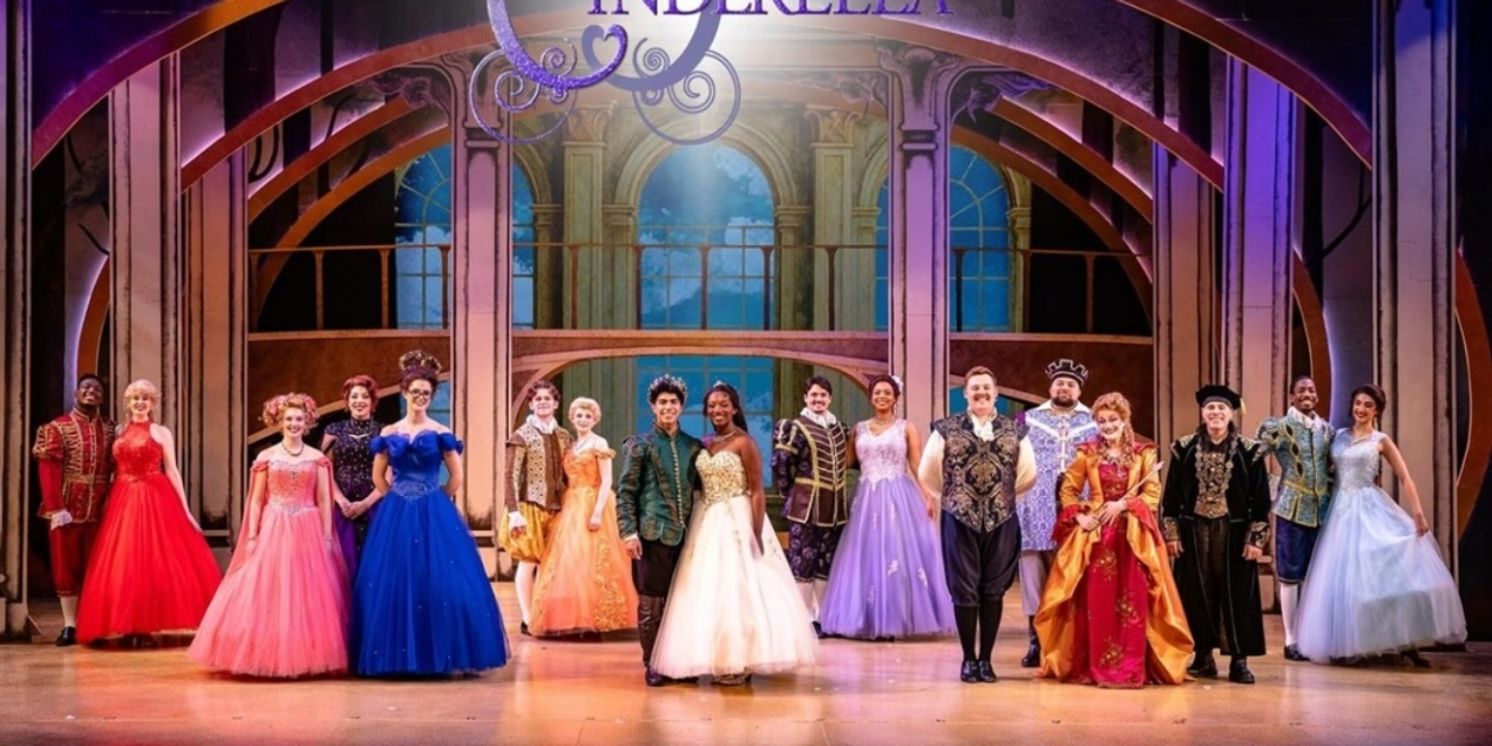Review: RODGERS AND HAMMERSTEIN’S CINDERELLA at Arizona Broadway Theatre
The production runs through July 26th at Arizona Broadway Theatre in Peoria, AZ.

Few stories have traveled through time and across cultures with as much resilience and reinvention as CINDERELLA. There’s the 1st-century tale of the Greek slave girl Rhodopis, whose rose-red sandal was snatched by an eagle and dropped before the Pharaoh, who then sought her out and made her queen. The 9th-century Chinese story of Ye Xian echoes the theme of a young woman, mistreated by a cruel stepmother and stepsister, who loses her golden slipper at a spring festival and is sought out by the king who has been captivated by her beauty and kindness. Charles Perrault’s Cinderella (1697) offered a gentler, more elegant and romanticized version of the tale—the one that inspired Disney’s adaptations, replete with the fairy godmother, pumpkin carriage, and glass slippers. In contrast, The Brothers Grimm’s 1812 version (Aschenputtel or The Little Ash Girl), known as the “violent fairy tale,” has stepsisters who mutilate their feet to fit the golden slipper.
You see the pattern: CINDERELLA has always been more than just a rags-to-riches fairy tale. It has served as an allegory of virtue rewarded. And, it's a story that has been endlessly reshaped to reflect the values and anxieties of the moment. Such was the case when Rodgers and Hammerstein adapted it for television in 1957, crafting a version that aligned with postwar ideals of domestic stability, romantic destiny, and moral clarity. Broadcast live to an audience of over 100 million viewers, the production embraced the optimism and conformity of the era, presenting a heroine whose goodness is rewarded with marriage and elevation into royalty—an aspirational fantasy for a nation seeking comfort, certainty, and shared spectacle.
It wasn’t until Douglas Carter Beane’s 2013 Broadway rewrite that Cinderella—now Ella—was granted more than a curfew and a pumpkin coach; she was given agency. The heart of the story is reimagined and the title character is elevated from a young woman of passive virtue to one of active compassion. Ella questions the structures of power and class, believing all the while in kindness and the possibility of change. It’s a story line that, on one level, will appeal to children seeking enchantment and, on another, to adults attuned to the undercurrents of social commentary. It’s a tightrope act that Arizona Broadway Theatre, under Nick Dalton’s direction, navigates with remarkable balance.
Ella (Chelsea Udoye) is not simply a dreamer or silent sufferer waiting to be rescued. She is a principled advocate for justice. The glass slipper remains. The magic, music, and romance are all there—but Ella’s true power lies in recognizing inequity and insisting that love without justice is a hollow crown. In this telling, Ella doesn’t just find her voice—she uses it.
Udoye’s portrayal of Ella blends warmth with quiet resolve and moral clarity. Her performance makes it clear that this Cinderella wins love not by luck, but by conviction. Topher (Christopher Arellano), the prince, is equally compelling—no longer a flat archetype but a young ruler-in-training, awakened to the realities of his kingdom by Ella’s courage. Together, Udoye and Arellano—blessed with soaring and expressive voices—create a chemistry rooted more in mutual respect and admiration rather than breathless romance—and that may be the point. Their connection is not rooted in rescue, but in recognition.
The supporting cast adds vivid color and dimension to the production. Andrew Hendrick brings commanding flair to Lord Pinkleton, serving as both royal herald and comedic foil with precision. Kimberly Abrams as Madame (Ella’s stepmother) is deliciously imperious, balancing villainy with a dose of theatrical panache. Devorah Joyce Coon’s Charlotte delivers physical humor and brashness that energize each of her scenes. Darren Friedman’s Sebastian provides a sly counterweight to the prince’s idealism, portraying a court adviser whose manipulation is subtle but impactful.
But it is Ivana Martinic, as Marie—the beggar woman who transforms into the fairy godmother—who leaves a lasting impression. With luminous stage presence and vocal power, Martinic infuses the role with warmth, wisdom, and a touch of mischief. Her performance grounds the story’s magic in a sense of moral clarity, reminding us that transformation begins not with wishes alone, but with the courage to believe in something better.
The ensemble supports the action with energy and polish, giving life (thanks to Kurtis Overby’s spirited choreography) to scenes of celebration and unrest alike.
Beane transforms the tale from romantic daydream into subtle political fable. He retains Rodgers and Hammerstein’s beloved score, but adds modern dialogue, sharp humor, and newly imagined characters—such as the rabble-rousing Jean-Michel (Ben Thomas Strong) and the compassionate stepsister Gabrielle (Karsten Lane Flake), a refreshing departure from the usual caricatures. These additions expand the narrative to explore social justice, civic engagement, and moral awakening.
Under Dalton’s direction, Arizona Broadway Theatre’s production embraces this modern heartbeat while honoring the timeless sweep of Rodgers and Hammerstein’s score. Songs like “In My Own Little Corner” become meditations on potential, while “Do I Love You Because You’re Beautiful?” takes on layered meaning in a world where appearances so often mask intent. Beane even includes trunk songs—pieces originally written for other Rodgers and Hammerstein musicals but cut before production. “Now Is the Time” and “Loneliness of Evening” (from South Pacific) and “Me, Who Am I?” (from “Me and Juliet”) are thoughtfully repurposed to underscore the show’s themes of activism and self-determination.
The production’s most successful elements are its visual inventiveness and tonal clarity. Matthew Herman’s dynamic design palette, accentuated by Heather Reynolds’s vibrant lighting effects and Olivia Herneddo’s enchanting projections, evokes the sensations of a fairy tale world. Morgan Andersen’s costumes dazzle in their transformation, yet never outshine the emotional arc of the characters. The overall aesthetic—playful yet purposeful—supports a production that walks the line between satire and sincerity.
In Arizona Broadway Theatre’s production of CINDERELLA, audiences of all ages will find the magic they came for…and in that space, a story once deemed simple becomes something richer. Perhaps that’s exactly what makes this version resonate. The tale has always been a cultural mirror—reflecting what we value, what we fear, and what we hope for. Arizona Broadway Theatre’s production reminds us that stories evolve because societies do. And in an age grappling with systemic injustice, rising inequality, and the redefinition of gender roles, perhaps it’s only right that Cinderella—now Ella—no longer waits in the ashes, but rises with her own voice.
RODGERS AND HAMMERSTEIN’S CINDERELLA runs through July 26th.
Arizona Broadway Theatre--https://azbroadway.org/--7701 W. Paradise Lane, Peoria, AZ--623-776-8400
Graphic credit to ABT
Reader Reviews

Videos

